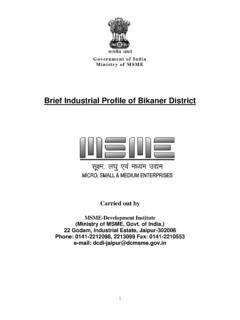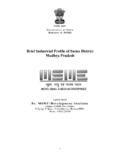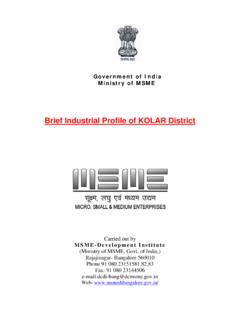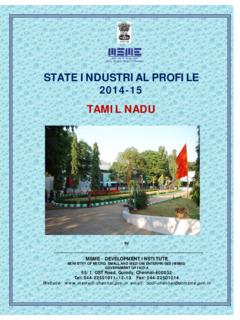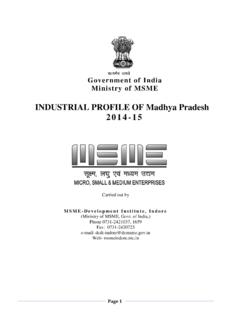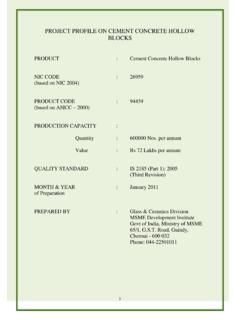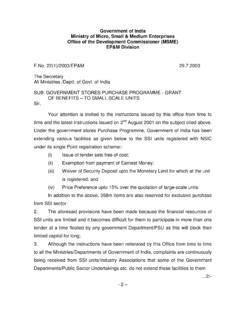Transcription of Brief Industrial Profile of Nagpur District - DCMSME
1 Government of India Ministry of MSME. Brief Industrial Profile of Nagpur District Carried out by MSME-Development Institute (Ministry of MSME, Govt. of India,). CGO Complex, Block C',Seminary Hills, Nagpur -440006. Phone: 0712-2510046, 2510352. Fax:0712- 2511985. Web- 1. Contents S. No. Topic Page No. 1. General Characteristics of the District 05. Location & Geographical Area 05. Topography 06. Availability of Minerals. 06-07. Forest 08. Administrative set up 08. 2. District at a glance 09-11. Existing Status of Industrial Area in the District Nagpur 12. 3. Industrial Scenario Of Nagpur 13-31. Industry at a Glance 13. Year Wise Trend Of Units Registered 13-14. Details Of Existing Micro & Small Enterprises & Artisan Units In The 15-18.
2 District Large Scale Industries / Public Sector undertakings 19-21. Major Exportable Item 21. Growth Trend 22-24. Vendorisation / Ancillarisation of the Industry 24. Medium Scale Enterprises 25-29. List of the units in Nagpur & near by Area 25-29. Major Exportable Item 29. Service Enterprises 29. Coaching Industry -- Potentials areas for service industry 29-30. 2. Potential for new MSMEs 31. 4. Existing Clusters of Micro & Small Enterprise 32-33. 5. General issues raised by industry association during the course of 34. meeting 6 Steps to set up MSMEs 35. 3. 4. Brief Industrial Profile of Nagpur District 1. General Characteristics of the District : For the purpose of administrative conveyance, the District is divided into Fourteen Tahsils and Thirteen Panchayat Samities.
3 According to the 2001 Census, there was 776 Gram Panchayat for the purpose of Rural Development. The main crop grown in the District is paddy, Jowar, Soyabean, Cotton Wheat and Tur. Nagpur District stretches over an area of 9892 Sq. Km. Area under Urban sector is Sq. Km. while the area under the rural sector is Sq. Km. In the terms of area, Nagpur District constitutes of the total area of the Maharashtra State. Total population of the District according to 2001 census was 4068 Thousands out of which 2105 Thousands were males and 1962 Thousands were females. Of the total population, 1454. Thousands is residing in rural area and 2614 Thousands is residing in Urban area. The density of the population according to the 2001 census was 405 persons/Sq.
4 Km. Location & Geographical Area: It is practically at geographical center of India, in fact the zero milestone of India is in this city. All major highways NH-7 ( Varanasi - Kanyakumari ) &. NH-6 (Mumbai - Sambalpur - Calcutta) amd major railways trunk route (Mumbai, Chennai, Howrah * Delhi) pass through the city. Important Central & State Government offices and institutions are located in Nagpur . Industrial Development is existing along the fringe areas like Kamptee, Hingna, Wadi, Khapri, Butibori and Kalmeshwar. Nagpur is 837 kms. From Mumbai, 1094 Kms south of Delhi, 1092 kms north of Chennai and 1140. kms west of Calcutta. Nagpur District lies between to North Latitude and to East Longitude.
5 The surrounding region is an undulating plateau rising northward to the Satpura Range, from 889 to 2,142 feet (271 to 653 m) high and is drained by the Kanhan and Pench rivers in the center, the Wardha in the west, and the Wainganga in the east. Both these rivers later merge as tributaries into the Godavari river. The soil is fertile black (cotton) in the west and the north and alluvial in the east. The average annual rainfall is 45 inches, with more rain in the east than in the west. In the west, the hills are forested. In the northeast are the hills of Ramtek. 5. Topography: Nagpur District lies between to North Latitude and to East Longitude., in the plain to which it gives its name at the southern base of the Satpuda Hills.
6 It has an area of 9,892 Sq. km. The District is bounded on the north by the Chhindwada and Seoni districts of the Madhya Pradesh, on the east by Bhandara, on the south and west by Chanda and Wardha, respectively, and along a small strip on the north- west by the Amravati District . The northern range of hills extends along the whole border, being pierced only in two places where the Kanhan and Pench rivers have broken through. On the west it consists merely of the outlying foothills of the Satpudas, the plateau proper lying behind them in Chhindwada. But from the Kanhan to the Pench, it is the major range of the Satpudas themselves which dominates the landscape, and the ascent of the Khamarpani plateau is made in Nagpur .
7 Along this length the hills are well wooded and picturesque, and there is some striking scenery on the Pench river. In the Archaean area the rocks are hidden beneath a considerable thickness of alluvial soil, deposited by the tributaries of the Kanhan and the Wainganga rivers. In the trappean area the soil is usually the black cotton soil known as regur with Kankar, which is also found in the soils on the Archaean areas. The climate of this District is characterised by a hot summer, well distributed rainfall and dryness except in the rainy season. The cold season is from December to February and is followed by the hot season from March to May. The south-west monsoon season is from June to September while the period October-November constitutes the post-monsoon season.
8 Availability of Minerals. Nagpur District is moderately rich in minerals. Deposits of Coal, Manganese ore, Dolomite, Limestone, Iron Ore, Clay, Copper Ore, Chromites, Tungsten Ore, Zinc Ore, Lead Ore, Granite, Quartz etc. are found in the District . 6. Coal reserves have been found in the North-West belt of the District from Saoner to Kanhan ( Kamptee apart from the high coal found in umrer tahsil). Nagpur District is richly endowed with Manganese Ore and the District is well placed in the country as far as production of Manganese ore is concerned. Manganese ore is found particularly in Ramtek and Saoner tahsils. Good quality limestone is found in Kandri and Deolapar, Mica and Tungsten are also found in the District .
9 The sand from Kanhan River is considered to be of high quality as far as the construction of building is concerned. PRODUCTION OF MINERAL 2010-11. NAME OF MINERAL PRODUCTION in 2010-2011. MAJOR MINERAL. 1 Manganese Ore 194127. 2 Coal 2256705. 3 Dolomite 19418. MINOR MINERALS PRODUCTION in MT. 2010-2011. Murum NA. Gitti/Bolder NA. Sand NA. SOURCE:- Dept. of Geology & Mines, Nagpur 7. FOREST. During the year 2010-11, an estimated 2765 Sq KM of area was under forest which constituted of the total area. Forest resources contribute significantly to the economy of the District . Most of the land under forest can be found on the banks of Pench River, at the foot hills of Satpuda in Ramtek tahsil. Teakwood is available from these forests in sizeable quantity.
10 The other resources are Tendu Patta, Gum, Bamboo, Grass etc. Administrative set up. For the purpose of administrative conveyance, the District is divided into fourteen Tahsils and Thirteen Panchayat Samities. According to the 2001 Census, there are 776 Gram Panchayat for the purpose of Rural Development. The Geographical area of Tahsils is given in the Table. Sl .No Name of the Tahsil Area in Sq. Km. 01 Nagpur Urban 02 Nagpur Rural 03 Hingana 04 Kamptee 05 Katol 06 Narkhed 07 Saoner 08 Kalmeshwar 09 Ramtek 10 Parseoni 11 Mauda 12 Umrer 13 Bhiwapur 14 Kuhi Total 9892. 8. 2. District at a glance Particular Year Unit Statistics 1 Geographical features (A) Geographical Data i) Latitude to ii) Longitude to iii) Geographical Area Sq.

